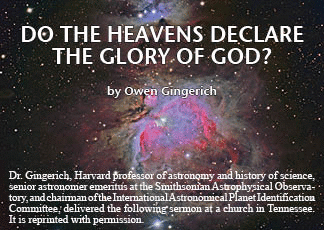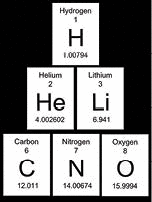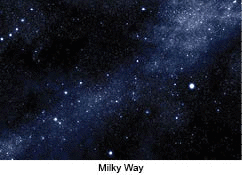Return to May/June 2015 articles.

Do the heavens declare the glory of God? Does the firmament show forth His handiwork? I'm sure [you] would be shocked if I simply said, “Yes,” and sat down. On the other hand, you would all be even more stunned if I said, “No, the heavens don't declare the glory of God,” and sat down. So, I think you can all safely deduce that there is something more to be said about the Psalmist's ancient declaration.
Back in my office in Cambridge I have a considerable collection of early astronomy textbooks, mostly small and cheaply printed. What was then the recent invention of letterpress printing made it possible for university students to have their very own copies of the textbook. This was particularly true at Martin Luther's university in Wittenberg, where the cheap, small textbooks were essentially invented around 1530. So it's inspiring to have a shelf-full of astronomy books written by authors who knew Martin Luther personally.
In these books I have placed my own bookplate, which includes the motto Coeli enarrant gloriam Dei — “The heavens are telling the glory of God” as translated in Haydn's glorious Creation oratorio. It's appropriate for my bookplate to be in Latin, since virtually all the astronomy books from that period are written in Latin.
When those authors looked up at the nighttime sky, they were perceiving a far different universe than we know today. They saw the moon and the stars that God had ordained. They knew the moon was 30 earth diameters away, actually a pretty good reckoning, and they thought the Sun was 20 times farther and therefore 20 times larger than the moon (since they both have the same apparent size during a total solar eclipse). Actually the Sun is 400 times farther and therefore 64 million times larger in volume than the Moon. Hell, deep inside the earth, was no doubt pretty much layered as Dante had described it, and as for hell fire, there was evidence for that any time a volcano erupted. As for heaven itself, it lay just beyond the shell of stars that enclosed the planetary system. It was the “habitacle of the blessed” as the English astronomer Thomas Digges would describe it later in the century. So, altogether, it was a pretty cozy universe. When a Wittenberg astronomer looked up at the majestic Milky Way spanning the sky on a clear dark night, the sight was awesome, indeed glorious, and God was not so far away. His view and his appreciation was not all that different from the ancient Psalmist himself.
 I, too, have witnessed the dazzling spangle of the Milky Way from the land of the Psalmist. I vividly remember the vista from a dark setting east of the Dead Sea, where I could almost reach up and pluck a star of my own. And besides the brilliance of the Milky Way, there was a much less common sight, the pyramid of a fainter glow in the west, the so-called zodiacal light, which I recognized as dust grains in the solar system reflecting the light of the sun. And to the east was the faint fuzzy patch of the Andromeda galaxy, an island universe two million light years away. It was the same sky the Psalmist saw, or Martin Luther saw, but in my 20th-century understanding the heavens were far vaster than either of them could have imagined. In both space and time in my mind's eye, my universe was overwhelmingly different from the heavens they saw and envisioned. It was a long time ago that I was on the West Bank, seeing that star-filled sky, and we then did not know whether the universe stretched to a distant horizon ten billion or 20 billion light years away. Today, we would put the horizon 13.7 billion light years away, and with the Hubble Space Telescope we can record galaxies in their infancy, nearly that old, born of the Big Bang cataclysm that started it all in an inconceivably immense split-second blast of energy that Martin Luther's astronomers could barely have imagined.
I, too, have witnessed the dazzling spangle of the Milky Way from the land of the Psalmist. I vividly remember the vista from a dark setting east of the Dead Sea, where I could almost reach up and pluck a star of my own. And besides the brilliance of the Milky Way, there was a much less common sight, the pyramid of a fainter glow in the west, the so-called zodiacal light, which I recognized as dust grains in the solar system reflecting the light of the sun. And to the east was the faint fuzzy patch of the Andromeda galaxy, an island universe two million light years away. It was the same sky the Psalmist saw, or Martin Luther saw, but in my 20th-century understanding the heavens were far vaster than either of them could have imagined. In both space and time in my mind's eye, my universe was overwhelmingly different from the heavens they saw and envisioned. It was a long time ago that I was on the West Bank, seeing that star-filled sky, and we then did not know whether the universe stretched to a distant horizon ten billion or 20 billion light years away. Today, we would put the horizon 13.7 billion light years away, and with the Hubble Space Telescope we can record galaxies in their infancy, nearly that old, born of the Big Bang cataclysm that started it all in an inconceivably immense split-second blast of energy that Martin Luther's astronomers could barely have imagined.
And so, asking the question, “Do the heavens declare the glory of God?” today, is not the same question, “Enarrantne coeli gloriam Dei?” that Martin Luther could have considered back in the days of Columbus, Leonardo da Vinci, or Copernicus.
We are no longer in ecstasy about the beauty of creation, but we are instead crushed down by our insignificance in the vastness of the universe. Rather than Psalm 19, we turn to Psalm 8: “When I consider thy heavens, the work of thy fingers, the moon and the stars which thou hast ordained; What is man that thou art mindful of him?” Where do we fit in as little specks in such an immense and ancient universe?
More than once I have been asked, “Why does the universe have to be so big and so old?” My answer is that I suppose the almighty Creator could have made the universe in many different ways, and our challenge as scientists is to discern how God did it. The mere fact that we creatures can ask this question tells us that there is some special relationship between ourselves as an intelligent species and the universe, itself. Of the millions of species that have been or are now on the earth, we uniquely have the ability to ask this question of how the universe and we ourselves in it have come to be. The mere fact that such a question can be asked in itself gives us some hint that a creative intelligence lies behind this universe. As Genesis 1:27 says, “God created man in his own image, male and female created he them.” That's undoubtedly the most important verse in the whole first chapter of the Bible. God as Creator has endowed us with creativity in his own image, the ability to research, to imagine, to discover many fascinating details about the nature and origin of the universe.
 So what is the consequence of a universe being so old? Our universe is made of many different things, atoms, dark matter, and dark energy, and most of these we barely understand apart from their being significant in the large
So what is the consequence of a universe being so old? Our universe is made of many different things, atoms, dark matter, and dark energy, and most of these we barely understand apart from their being significant in the large  scale structure of the universe. But we know we wouldn't be here without atoms, and in particular we need oxygen and carbon, the basis of organic chemistry. In the Big Bang, when pure energy was being turned into matter, huge amounts of the simplest atom, hydrogen, were produced.
scale structure of the universe. But we know we wouldn't be here without atoms, and in particular we need oxygen and carbon, the basis of organic chemistry. In the Big Bang, when pure energy was being turned into matter, huge amounts of the simplest atom, hydrogen, were produced.  That happened in the first three minutes. But carbon and oxygen were not made, so these and other atoms required for life were lacking.
That happened in the first three minutes. But carbon and oxygen were not made, so these and other atoms required for life were lacking.
These critical elements came along much later, through nuclear reactions in the hot interiors of evolving giant stars, and they came about much, much more slowly.
Sunday morning is probably not the best time for a lecture on nuclear physics, but there is one detail of the story that is really quite astonishing — the reason there wasn't any carbon in the initial brew. In principle, elements could be made by sticking the simple hydrogen atoms together and going up the ladder to form heavier and heavier atoms. If basic hydrogen atoms have a mass of one unit, stick two together and you get heavy hydrogen of mass 2, stick another onto that and get mass 3, and another for mass 4, which turns out to be a helium atom, and so on up the ladder to 12, which is a carbon atom. The problem is that mass 5 isn't stable. It almost always falls apart in a split second before another hydrogen can be added, so the process simply didn't climb the ladder. In those first few minutes, the universe was cooling down so rapidly that the Big Bang was over before the heavier atoms had a chance to be formed. To get around this obstacle requires lots more time, like billions of years. That's why we need a very old universe, to get the building blocks for life.
 In the 1950s, the maverick British astronomer Fred Hoyle made some calculations about how much time it would take to cook up these critical elements in the cores of giant stars, and found that with ordinary structures in the nuclei of carbon and oxygen atoms, ten billion years still wouldn't be enough time to make significant quantities of these important elements. The missing mass 5 was a serious obstacle.
In the 1950s, the maverick British astronomer Fred Hoyle made some calculations about how much time it would take to cook up these critical elements in the cores of giant stars, and found that with ordinary structures in the nuclei of carbon and oxygen atoms, ten billion years still wouldn't be enough time to make significant quantities of these important elements. The missing mass 5 was a serious obstacle.
But because we do have carbon and oxygen, there had to be something else going on, some undiscovered feature in the structure of the carbon nucleus that raised the probability of its being formed, and Hoyle made a prediction of what it would be. There had to be what is called a resonance at a precise energy level in the carbon atom. Hoyle was at that moment on leave in Pasadena, so he went to physicist Willy Fowler, who had access to an atom-smashing accelerator that could probe the nuclear resonance levels. Fowler thought it was kind of crazy that this visiting Englishman believed he could predict the inner structure of the carbon nucleus, but he agreed to try, and there it was. Not only was it there, but at precisely the right energy level. Four percent lower, and there would be essentially no carbon.
Long ago, I had heard rumors that nothing had shaken Hoyle's atheism as much as this discovery. From time to time, I had occasion to discuss one thing or another with him, but I never had quite enough nerve to say, “Fred, is it really true that the resonance level in the carbon atom has shaken your atheism? Do you believe the heavens declare the glory of God?”
 But an answer of sorts came when he wrote about his discovery in the Cal Tech alumni magazine as follows: “Would you not say to yourself, ‘Some supercalculating intellect must have designed the properties of the carbon atom, otherwise the chance of my finding such an atom through the blind forces of nature would be utterly minuscule.’ Of course you would … . A common sense interpretation of the facts suggests that a superintellect has monkeyed with physics, as well as with chemistry and biology, and that there are no blind forces worth speaking about in nature. The numbers one calculates from the facts seem to me so overwhelming as to put this conclusion almost beyond question.”
But an answer of sorts came when he wrote about his discovery in the Cal Tech alumni magazine as follows: “Would you not say to yourself, ‘Some supercalculating intellect must have designed the properties of the carbon atom, otherwise the chance of my finding such an atom through the blind forces of nature would be utterly minuscule.’ Of course you would … . A common sense interpretation of the facts suggests that a superintellect has monkeyed with physics, as well as with chemistry and biology, and that there are no blind forces worth speaking about in nature. The numbers one calculates from the facts seem to me so overwhelming as to put this conclusion almost beyond question.”
That's a truly remarkable quotation, especially considering the fact that Hoyle already had a reputation as a public skeptic. The numbers do give us some pause. If they had only slightly different values, we wouldn't be here. And these are not the only physical settings that are so subtly configured. The British Astronomer Royal, Martin Rees, has written a book entitled Just Six Numbers. In it, he points out six numbers that describe our physical world whose precise values are essential for a life-bearing universe. Tweak them only slightly and our universe would be devoid of life. These and other very sensitively-set numbers are what we refer to as fine tuning.
a book entitled Just Six Numbers. In it, he points out six numbers that describe our physical world whose precise values are essential for a life-bearing universe. Tweak them only slightly and our universe would be devoid of life. These and other very sensitively-set numbers are what we refer to as fine tuning.
We have to be very pleased about this situation, since our existence depends on it.
Is the universe declaring something? That makes many of my physicist friends very nervous. They don't like the idea of a supercalculating intellect tinkering with the universe. That wouldn't be natural; the universe wouldn't be entirely subject to physical laws they could discover. It would be supernatural, and that would be superstitious.
 When Isaac Newton described the role of gravity in keeping our moon in tow, the French scientists cried, “Superstitious!” How could the Earth affect the Moon if nothing was touching it? It was the same when Kepler proposed that the moon controlled the tides. Galileo declared, “I am surprised that the most astute Kepler gives ear to such superstitions.”
When Isaac Newton described the role of gravity in keeping our moon in tow, the French scientists cried, “Superstitious!” How could the Earth affect the Moon if nothing was touching it? It was the same when Kepler proposed that the moon controlled the tides. Galileo declared, “I am surprised that the most astute Kepler gives ear to such superstitions.”
It doesn't disturb me that the universe could be designed for life, superstitious as that might be. I must warn you that I'm psychologically incapable of believing that the universe is purposeless. I like the analogy that the distinguished physicist John Wheeler proposed. He likened the universe to a giant plant whose purpose was ultimately to bring forth one small, delicate flower. Wheeler suggested that we are that one small flower of the universe, and that our destiny and purpose is to understand the universe. Perhaps the universe is designed to be understandable, and we as human beings are at work trying to understand the universe and its laws. The human brain is the single most complex thing we know about in the entire universe. What better instrument to contemplate the universe? Ironically, our brains are complex enough even to contemplate the possibility that our brains might not be the most complex things in the universe!
But if our purpose in this universe is to understand God through the majesty of this universe, I have a problem. This opens us to a God of very large numbers. The energy required for the Big Bang is incomprehensibly large. As the physics is calculated back in time, the universe gets hotter and hotter, the elapsed time to the beginning of time, itself, becomes smaller and smaller, but the number gets huge in its tininess, 10 to the minus 43 seconds before which the physics runs out. And the time back to the beginning, nearly 14 billion years is staggering. (If you wanted to count to just one billion, two numbers per second, counting day and night, would take you 31 years.)
A God of very large numbers is impressive, but it is not a God we would choose to worship. A God of incomprehensible majesty, yes. But trying to understand that God is like the puppy trying to understand Isaac Newton. Is it just wishful thinking when we say that the heavens declare the glory of God?
But wait a minute! A God of such magnificence and wisdom could well have power to limit itself, to wear a mask of himself or herself in order to relate to its creatures. And notice that word “creatures” — in itself, this carries the idea of our being created. Created creatures with the power to think, to think theologically, to think inspired thoughts.
If we regard God's world as a site of purpose and intention and accept that we, as contemplative surveyors of the universe, are included in that intention, then the vision is incomplete without a role for divine communication, a place for God both as Creator-Sustainer and as Redeemer, a powerful transcendence that not only can be a something but can take on the mask of a someone; a  which that can connect with us as a who. Such communication will be best expressed through personal relationships, through wise voices and prophets in many times and places. The divine communication will carry a moral dimension, only dimly perceived in the grandeur of creation, yet present through the self-limitation of the Creator who has given both natural laws and freedom within its structure. Here, implications for human morality are discernible, for this view implies a self-renunciatory ethic. As Jesus said to Pilate, “My kingdom is not of this world; if my kingdom were of this world, then my followers would fight.”
which that can connect with us as a who. Such communication will be best expressed through personal relationships, through wise voices and prophets in many times and places. The divine communication will carry a moral dimension, only dimly perceived in the grandeur of creation, yet present through the self-limitation of the Creator who has given both natural laws and freedom within its structure. Here, implications for human morality are discernible, for this view implies a self-renunciatory ethic. As Jesus said to Pilate, “My kingdom is not of this world; if my kingdom were of this world, then my followers would fight.”
Within the framework of Christianity, Jesus is the supreme example of personal communication from God, an exemplary life of service, of forgiveness, of sacrifice.
 When the apostle Philip requested, “Show us the Father,” Jesus responded, “Anyone who has seen me has seen the Father.” When Jesus, hanging on the cross and slowly suffocating, cried out, “My God, my God, why hast thou forsaken me?” the nature of God's self-limited world became excruciatingly clear. God acts within the world, but not always in the ways most obvious to our blinkered vision.
When the apostle Philip requested, “Show us the Father,” Jesus responded, “Anyone who has seen me has seen the Father.” When Jesus, hanging on the cross and slowly suffocating, cried out, “My God, my God, why hast thou forsaken me?” the nature of God's self-limited world became excruciatingly clear. God acts within the world, but not always in the ways most obvious to our blinkered vision.
 This view of the central message of the biblical story is not closely tied to the heavens declaring the glory of God. Still, I can't help but remember the thrill I had, as a ten-year-old, when I was able to see the rings of Saturn with a simple telescope my father helped to build, and the excitement of sharing that view with my fourth-grade teacher. Likewise, a year later, when I saw a stunning view of the moon with the 60-inch reflector on Mount Wilson, I had to be impressed with God's glory. But it was not just when I was a kid. Watching the eclipsing moon slowly move across the disk of the sun, and then suddenly, like a light switch turning off the light, the darkness and the eclipsed sun, which you can admire directly without a dark filter, like a sparkling jeweled ring on black velvet — it's enough to raise the pulse even of a skeptic.
This view of the central message of the biblical story is not closely tied to the heavens declaring the glory of God. Still, I can't help but remember the thrill I had, as a ten-year-old, when I was able to see the rings of Saturn with a simple telescope my father helped to build, and the excitement of sharing that view with my fourth-grade teacher. Likewise, a year later, when I saw a stunning view of the moon with the 60-inch reflector on Mount Wilson, I had to be impressed with God's glory. But it was not just when I was a kid. Watching the eclipsing moon slowly move across the disk of the sun, and then suddenly, like a light switch turning off the light, the darkness and the eclipsed sun, which you can admire directly without a dark filter, like a sparkling jeweled ring on black velvet — it's enough to raise the pulse even of a skeptic.
We know we're living at a very special time in the history of the universe, when the apparent size of the moon just covers the sun. In the far future it won't be like this, but for now it is one of the most breathtaking views from or on our planet. Yet I doubt that that's enough to sway a skeptic. And perhaps that's how it should be. There's a telling passage in First Kings: “And, behold, the Lord passed by, and a great and strong wind rent the mountains, and brake in pieces the rocks before the Lord; but the Lord was not in the wind: and after the wind an earthquake; but the Lord was not in the earthquake: And after the earthquake a fire; but the Lord was not in the fire: and after the fire a still small voice.”
The message is in a still, small voice, God's inspiration, literally the bringing in of the Spirit. The glory of the heavens doesn't knock the skeptic from his perch. It's in the eye of the beholder. For me the glory of the heavens inspires me to understand the handiwork of the Lord. However, it doesn't work for everyone. But let me quote a public skeptic, in a little known passage from Fred Hoyle, made near the end of his life: “The issue of whether the universe is purposive is an ultimate question that is at the back of everybody's mind … . And Dr. [Ruth Nanda] Ashen has now just raised exactly the same question as to whether the universe is a product of thought. And I have to say that that is also my personal opinion, but I can't back it up by too much of precise argument. There are very many aspects of the universe where you either have to say there have been monstrous coincidences, which there might have been, or, alternatively, there is a purposive scenario to which the universe conforms.”
As I said earlier, I'm psychologically incapable of believing the universe is purposeless. So, unlike Fred Hoyle, I'm not sitting on the fence. Let me simply say that the sheer beauty of the heavens declares the glory of God!
From the American Scientific Affiliation: http://godandnature.asa3.org/essay-do-the-heavens-declare-the-glory-of-god.html

Picture credits:
© rwittich. Image from BigStockPhoto.com.
© Rastan. Image from BigStockPhoto.com.
© All three element graphics © Nerthuz. Image from BigStockPhoto.com.
© joejayphotos. Image from BigStockPhoto.com..
© rwittich. Image from BigStockPhoto.com.
© rwittich. Image from BigStockPhoto.com..
© Tjefferson. Image from BigStockPhoto.com.
© 3quarks. Image from BigStockPhoto.com.
© CHOReograPH. Image from BigStockPhoto.com.
© zurijeta. Image from BigStockPhoto.com
